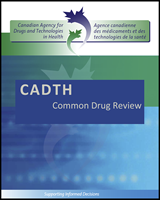| Drug | Botulinum toxin type A, 31 to 39 injections of 5 units every 12 weeks | Botulinum toxin type A purified neurotoxin complex, dose not specified. |
| Price | £276.40 per vial (assuming 5 sets of injections per year = £1,382) | £1,198 per year (based on 5 sets of injections) | Not reported |
| Treatment | Reported as Botulinum toxin type A (although, clinical data were from PREEMPT studies in which patients in both arms used concomitant acute medications) |
| Comparator | Placebo | BSC (which includes combinations of first-line oral prophylactics, off-label prophylactics, GON blocks and in some cases acute migraine medications only), but SMC considered placebo more appropriate. | BSC (use of acute headache pain medications as required). PBAC considered other oral prophylactic treatments to be more appropriate, but agreed BSC was appropriate in subsequent applications. |
| Population Modelled | Adults with CM (whose condition has failed to respond to three or more prior pharmacological prophylactic therapies) | Adults with CM who had previously failed on oral prophylactic therapy due to side effects or lack of efficacy. | Adult patients with CM who failed 2 or more [initial] and 3 or more [subsequent] prior prophylactic treatments. |
| Time Horizon | 2 years | 5 years |
| Discount Rate | 3.5% p.a. on both costs and outcomes | Not reported |
| Type of Model | Markov model with 6 defined health states | CUA (model type not reported) | Markov model over six health states. Resubmission presented a model with three health states in a SA. |
| Key Outcomes | QALYs |
| Results | Base case: £6,083 per QALY.
Full population: £5,828 per QALY.
SA: Majority of NICE reanalyses found the ICUR to be between £11,267 and £20,324 per QALY.
A revised economic model was submitted where NICE found the ICUR to be closer to £18,000. | Base case: £17,436 per QALY.
SA: results sensitive to changes in utility values and time horizon (increase ICUR to £24,000 per QALY). | Base case: $15,000 to $45,000 per QALY.a
However, PBAC noted this may not represent the true cost-effectiveness of botulinum toxin treatment in clinical practice, given a number of issues with the economic evaluation. |
| Sources of Uncertainty | Concern about whether blinding was maintained in studies, use of discontinuation in the model, application of stopping rules in practice | Resource use, clinical data (post hoc analysis), continued efficacy of treatment, other costs not considered (training). | Transitional probabilities, time horizon, application of stopping rules in practice, utility values, extrapolation of the incremental treatment effect in the absence of supportive evidence. |
| CDR Assessment | The model structure submitted to CDR appears to have been similar to those submitted to other HTA agencies. |

